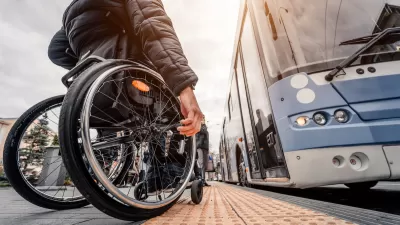A new study assesses which cities have the broadest access to walkable neighborhoods.

Urban planners frequently tout the benefits of walkability. But as Kea Wilson explains in Streetsblog USA, for many households, walkable neighborhoods just aren’t affordable. A new study sheds light on how walkability interacts with affordability. “Perhaps unsurprisingly, the researchers found that Americans on the whole will pay significantly more for the privilege of living in a place where they can get around on their own power: specifically, 35 percent more for home buyers, 41 percent more for apartment renters, and 44 percent more for office properties.”
According to an analysis from Smart Growth America, the city with the most equitable walkability in the United States is Cleveland, Ohio. According to Michael Rodriguez, visiting director of research at SGA, “Cleveland was at one point the fourth largest city in the U.S., and if you look at old images and videos of it, it was [as] vibrant as midtown Manhattan. These were proper cities, and we chose to enact policies that decimated that — but whatever we have left still provides a core of walkability today.”
“Perhaps shockingly, notoriously expensive New York City actually ranked second on the Social Equity Index, which he attributes to its proportionally high median incomes, astounding diversity, and the sheer preponderance of transit and people-oriented places that make car-free living possible for virtually everyone; residents of Manhattan, after all, spend an average of 37 percent of their income on housing and transportation combined, while residents of car-oriented Indianapolis spend 42, according to the Housing and Transportation Index.”
Wilson admits that New York City is an outlier, a megacity with many wealthy residents, but argues that equitable access to walkable communities shouldn’t be an anomaly. It could be part of every city if more effort was made to “implement zoning reforms, foster non-automotive travel, and invest in affordable housing for all.”
FULL STORY: America’s Most Equitably Walkable City is … Cleveland?

Alabama: Trump Terminates Settlements for Black Communities Harmed By Raw Sewage
Trump deemed the landmark civil rights agreement “illegal DEI and environmental justice policy.”

Planetizen Federal Action Tracker
A weekly monitor of how Trump’s orders and actions are impacting planners and planning in America.

The 120 Year Old Tiny Home Villages That Sheltered San Francisco’s Earthquake Refugees
More than a century ago, San Francisco mobilized to house thousands of residents displaced by the 1906 earthquake. Could their strategy offer a model for the present?

In Both Crashes and Crime, Public Transportation is Far Safer than Driving
Contrary to popular assumptions, public transportation has far lower crash and crime rates than automobile travel. For safer communities, improve and encourage transit travel.

Report: Zoning Reforms Should Complement Nashville’s Ambitious Transit Plan
Without reform, restrictive zoning codes will limit the impact of the city’s planned transit expansion and could exclude some of the residents who depend on transit the most.

Judge Orders Release of Frozen IRA, IIJA Funding
The decision is a victory for environmental groups who charged that freezing funds for critical infrastructure and disaster response programs caused “real and irreparable harm” to communities.
Urban Design for Planners 1: Software Tools
This six-course series explores essential urban design concepts using open source software and equips planners with the tools they need to participate fully in the urban design process.
Planning for Universal Design
Learn the tools for implementing Universal Design in planning regulations.
Clanton & Associates, Inc.
Jessamine County Fiscal Court
Institute for Housing and Urban Development Studies (IHS)
City of Grandview
Harvard GSD Executive Education
Toledo-Lucas County Plan Commissions
Salt Lake City
NYU Wagner Graduate School of Public Service





























